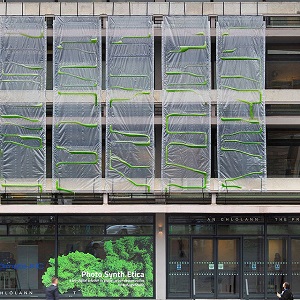 Thursday, April 25, 2024
Thursday, April 25, 2024  Thursday, April 25, 2024
Thursday, April 25, 2024 
Got news? Next submission deadline is Friday at 5:00 p.m.
Click here to submit YOUR news

For years now, designers and architects have been reimagining the ways biology might seamlessly merge with design and architecture in order to create more sustainable cities and products, resulting in new-fangled ideas like biomimicry, ‘genetic’ architecture that can respond to stimuli, and even mushroom-based ‘mycotecture‘.
Perhaps not surprisingly, algae might be part of the solution too, as a UK-based consortium is demonstrating with an intriguing installation of algal curtains that can help buildings clean polluted urban air. Created by Photo.Synth.Etica — a collaborative group made up of ecoLogicStudio, UCL’s Urban Morphgenesis Lab and University of Innsbruck’s Synthetic Landscapes Lab — the AlgaeClad system captures carbon dioxide from the atmosphere and stores it in real-time.
According to architects Claudia Pasquero and Marco Poletto of ecoLogicStudio, the large-scale algal curtains are architectural add-ons, capable of storing the same amount of CO2 as twenty large trees (about one kilogram of CO2 per day):
AlgaeClad is the world first living ETFE cladding. It requires far less structural support and its carbon footprint could be 80 times lower than an equivalent system in glass. This makes it particularly suitable for retrofitting projects. Our partnership with UCL allows us to develop a unique combination of engineered algae strands and digitally manufactured ETFE cushions, which gives the system exceptional resilience, low maintenance and suitability for dense urban environments. [..]
Designed to be integrated into both existing and new buildings, it is composed of 16.2 x 7 metre (53 x 23 feet) modules, each one functioning as a photobioreactor — a digitally designed and custom made bioplastic container — using daylight to feed the living micro-algal cultures and releasing luminescent shades at night.
Keep reading on TreeHugger.com
Watch the video and learn more about the benefits of joining Construction Links Network – the peer-to-peer network sharing platform for the construction, building and design community.
Ideal for YOUR Press Releases | Project Updates | New Appointments | Awards & Milestones | Company News | New Products/Services | Brochures | Videos | Infographs | Blog Sharing | Events and More